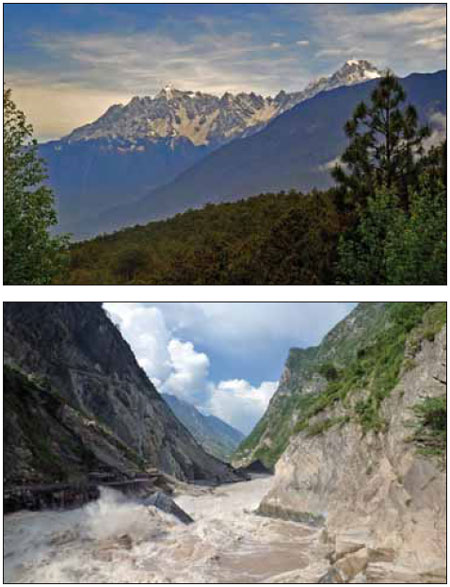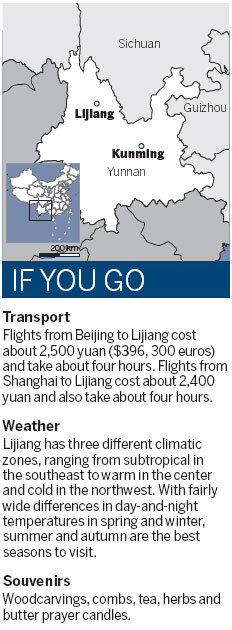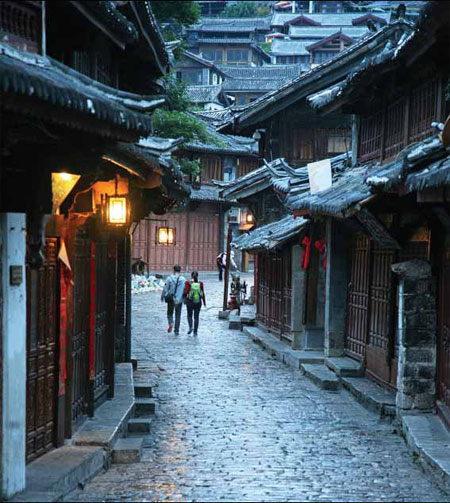Ethnic escape
Updated: 2012-09-20 13:35
(China Daily)
|
||||||||
|
Above: Lijiang Old Town, going back more than 800 years, is a center of the Naxi ethnic group. Below: Jade Dragon Snow Mountain is made up of 13 peaks, and Tiger Leaping Gorge is considered one of the world's deepest. Photos Provided to China Daily |


A trip to a city in yunnan offers the chance to take a step back in time
Mention international hotel chains in Chinese tourism and many will think of coastal getaways like Sanya in southern Hainan province. But international hotels such as Accor, InterContinental Hotels Group, and the boutique hotel chain Banyan Tree have been racing to invest in Lijiang, a historic town in Yunnan province.
Tourism revenue for the city of Lijiang rose to 10.4 billion yuan ($1.6 billion, 1.3 billion euros) in the first six months this year, an increase of 56.1 percent year-on-year, industry figures show. International visitors contributed 9 billion yuan to the sector, with an increase of 20 percent year-on-year, according to the Lijiang Tourism Bureau.
In a recent survey conducted by Sina.com, Lijiang, garnering 29.4 percent of the votes, was held up as a top destination for tourism investment.
Located in the northwest of Yunnan, Lijiang has always been a hub of the ancient Tea Horse Road, a legendary trade route linking Yunnan with Sichuan and Tibet. Beyond "business as usual", the area continues to wow and inspire with its 2,400-meter-high alpine scenery, three UNESCO world heritages and colorful ethnic culture.
Here are a few places worth exploring for business and leisure visitors alike:
1. Lijiang Old Town
The old town, going back more than 800 years, is a well-preserved enclave of winding, narrow cobbled streets, wooden houses with tiled roofs and nights illuminated by red lanterns.
Some have raised concerns that the old town is becoming too commercial, but guests can still enjoy a different world by wandering through the streets filled with silver handicraft shops, teahouses and canals crisscrossed by bridges.
As a center of the Naxi ethnic group, the old town is home to the Dongba (Naxi priests) culture that has received renewed interest in recent years. One of the most significant traits of the Dongba is its language - the Dongba script is said to be the world's only surviving pictographic language still in use, although it is almost extinct. Local residents, especially shamans, still use the script, which is seen in every corner of the town.
Those interested in historical and cultural sites can head to the Museum of Naxi Dongba Culture. The museum presents rich ethnic information through paintings, sculptures and pottery. Scribes, including old shamans, can also write blessings for visitors.
2. Jade Dragon Snow Mountain
This holy site of the Naxi is about 30 minutes' drive north of the Old Town. As the southernmost glacier in the northern hemisphere, the snow-capped mountain is made up of 13 peaks, with Shanzidou its highest at 5,600 meters. The mountain looks like a winding dragon in the clouds, which gives it its name.
The pristine environment with rare flora and fauna makes the place a big attraction for ecologists and urbanites looking to escape the hustle and bustle of cities. The mountain boasts a wide variety of different ecosystems, including meadows, forests and lakes.
The region abounds with legends of the Naxi, one being that those unhappy with their arranged marriages fled into the mountains.
Jade Dragon Snow Mountain is also home to the rare Wild Snow Tea, said to ease high blood pressure. In winter, the Naxi brave the cold and snow to pick the prized plant.
3. Tiger Leaping Gorge
This gorge, west of Jade Dragon Snow Mountain, is considered one of the world's deepest. The water flowing through it originates from Jinsha River and it is the narrowest segment as well as the strongest of the waterway.
The gorge is about 15 km long. A huge rock lies amid the rapids, and legend has it that a tiger used it as a stepping stone to leap from one side of the gorge to the other - hence its name.
Those looking for more thrills can try water rafting in the rapids. Slower sections of the waterway are also available to complement any relaxing trek or hike.
Dining and drinking
Local Naxi cuisine is a blend of Sichuan and Tibetan cuisines. Tasty snacks can be found in Lijiang Old Town, with Jidouliangfen (pea jelly salad) one of the Naxi favorites. Baba, a kind of fried pancake made of wheat, potato and meat, is also a must-try.
Others such as butter tea, thick herbal soup and Bingfenliangxiao (a dessert made of rice and rose) are also top choices.
The center of the Old Town offers a number of restaurants, cafes and pubs that also offer Western food such as pizza, hamburgers, sandwiches and pasta.
China Daily
(China Daily 09/20/2012 page23)

 'Taken 2' grabs movie box office crown
'Taken 2' grabs movie box office crown
 Rihanna's 'Diamonds' tops UK pop chart
Rihanna's 'Diamonds' tops UK pop chart
 Fans get look at vintage Rolling Stones
Fans get look at vintage Rolling Stones
 Celebrities attend Power of Women event
Celebrities attend Power of Women event
 Ang Lee breaks 'every rule' to make unlikely new Life of Pi film
Ang Lee breaks 'every rule' to make unlikely new Life of Pi film
 Rihanna almost thrown out of nightclub
Rihanna almost thrown out of nightclub
 'Dark Knight' wins weekend box office
'Dark Knight' wins weekend box office
 'Total Recall' stars gather in Beverly Hills
'Total Recall' stars gather in Beverly Hills
Most Viewed
Editor's Picks

|

|

|

|

|

|
Today's Top News
Health new priority for quake zone
Xi meets US top military officer
Japan's boats driven out of Diaoyu
China mulls online shopping legislation
Bird flu death toll rises to 22
Putin appoints new ambassador to China
Japanese ships blocked from Diaoyu Islands
Inspired by Guan, more Chinese pick up golf
US Weekly

|

|







